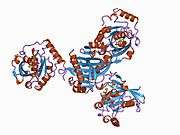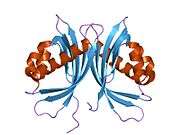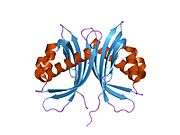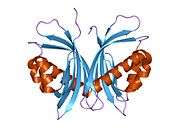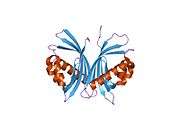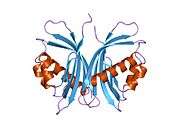NUTF2
Nuclear transport factor 2 is a protein that in humans is encoded by the NUTF2 gene.[4][5][6]
Function
The protein encoded by this gene is a cytosolic factor that facilitates protein transport into the nucleus. It interacts with the nuclear pore complex glycoprotein p62. This encoded protein acts at a relative late stage of nuclear protein import, subsequent to the initial docking of nuclear import ligand at the nuclear envelope. It is thought to be part of a multicomponent system of cytosolic factors that assemble at the pore complex during nuclear import.[6]
Interactions
NUTF2 has been shown to interact with Nucleoporin 62[4]{[7] and RAN.[8][9]
gollark: No.
gollark: Idea: deploy orbital lasers against 263274173223272449.
gollark: Heavpoot is not a... female dog?
gollark: Anyway, it's bizarre to go around complaining about me watching CIA-created stuff with no actual knowledge of what I watch, the difference between what you and me watch, and any explanation of what you actually mean by it.
gollark: Fascinating.
References
- GRCh38: Ensembl release 89: ENSG00000102898 - Ensembl, May 2017
- "Human PubMed Reference:". National Center for Biotechnology Information, U.S. National Library of Medicine.
- "Mouse PubMed Reference:". National Center for Biotechnology Information, U.S. National Library of Medicine.
- Paschal BM, Gerace L (Jun 1995). "Identification of NTF2, a cytosolic factor for nuclear import that interacts with nuclear pore complex protein p62". J Cell Biol. 129 (4): 925–937. doi:10.1083/jcb.129.4.925. PMC 2120498. PMID 7744965.
- Grundmann U, Nerlich C, Rein T, Lottspeich F, Küpper HA (Jul 1988). "Isolation of cDNA coding for the placental protein 15 (PP15)". Nucleic Acids Res. 16 (10): 4721. doi:10.1093/nar/16.10.4721. PMC 336660. PMID 3380696.
- "Entrez Gene: NUTF2 nuclear transport factor 2".
- Hu T, Guan T, Gerace L (Aug 1996). "Molecular and functional characterization of the p62 complex, an assembly of nuclear pore complex glycoproteins". J. Cell Biol. 134 (3): 589–601. doi:10.1083/jcb.134.3.589. PMC 2120945. PMID 8707840.
- Cushman I, Bowman BR, Sowa ME, Lichtarge O, Quiocho FA, Moore MS (Nov 2004). "Computational and biochemical identification of a nuclear pore complex binding site on the nuclear transport carrier NTF2". J. Mol. Biol. 344 (2): 303–310. doi:10.1016/j.jmb.2004.09.043. PMID 15522285.
- Stewart M, Kent HM, McCoy AJ (Apr 1998). "Structural basis for molecular recognition between nuclear transport factor 2 (NTF2) and the GDP-bound form of the Ras-family GTPase Ran". J. Mol. Biol. 277 (3): 635–646. doi:10.1006/jmbi.1997.1602. PMID 9533885.
Further reading
- Bukrinsky MI, Haffar OK (1998). "HIV-1 nuclear import: matrix protein is back on center stage, this time together with Vpr". Mol. Med. 4 (3): 138–43. doi:10.1007/BF03401911. PMC 2230352. PMID 9562972.
- Stewart M (2001). "Insights into the molecular mechanism of nuclear trafficking using nuclear transport factor 2 (NTF2)". Cell Struct. Funct. 25 (4): 217–225. doi:10.1247/csf.25.217. PMID 11129791.
- Bohn H, Johannsen R, Kraus W (1981). "[New placental protein (PP15) with immunosuppressive properties (author's transl)]". Arch. Gynecol. 230 (2): 167–72. doi:10.1007/BF02108272. PMID 7458421.
- Hu T, Guan T, Gerace L (1996). "Molecular and functional characterization of the p62 complex, an assembly of nuclear pore complex glycoproteins". J. Cell Biol. 134 (3): 589–601. doi:10.1083/jcb.134.3.589. PMC 2120945. PMID 8707840.
- Bullock TL, Clarkson WD, Kent HM, Stewart M (1996). "The 1.6 angstroms resolution crystal structure of nuclear transport factor 2 (NTF2)". J. Mol. Biol. 260 (3): 422–431. doi:10.1006/jmbi.1996.0411. PMID 8757804.
- Clarkson WD, Corbett AH, Paschal BM, Kent HM, McCoy AJ, Gerace L, Silver PA, Stewart M (1997). "Nuclear protein import is decreased by engineered mutants of nuclear transport factor 2 (NTF2) that do not bind GDP-Ran". J. Mol. Biol. 272 (5): 716–730. doi:10.1006/jmbi.1997.1255. PMID 9368653.
- Stewart M, Kent HM, McCoy AJ (1998). "Structural basis for molecular recognition between nuclear transport factor 2 (NTF2) and the GDP-bound form of the Ras-family GTPase Ran". J. Mol. Biol. 277 (3): 635–646. doi:10.1006/jmbi.1997.1602. PMID 9533885.
- Ribbeck K, Lipowsky G, Kent HM, Stewart M, Görlich D (1999). "NTF2 mediates nuclear import of Ran". EMBO J. 17 (22): 6587–6598. doi:10.1093/emboj/17.22.6587. PMC 1171005. PMID 9822603.
- Steggerda SM, Black BE, Paschal BM (2000). "Monoclonal antibodies to NTF2 inhibit nuclear protein import by preventing nuclear translocation of the GTPase Ran". Mol. Biol. Cell. 11 (2): 703–19. doi:10.1091/mbc.11.2.703. PMC 14804. PMID 10679025.
- Freire J, Covelo G, Sarandeses C, Díaz-Jullien C, Freire M (2001). "Identification of nuclear-import and cell-cycle regulatory proteins that bind to prothymosin alpha". Biochem. Cell Biol. 79 (2): 123–131. doi:10.1139/bcb-79-2-123. PMID 11310559.
- Cushman I, Bowman BR, Sowa ME, Lichtarge O, Quiocho FA, Moore MS (2004). "Computational and biochemical identification of a nuclear pore complex binding site on the nuclear transport carrier NTF2". J. Mol. Biol. 344 (2): 303–310. doi:10.1016/j.jmb.2004.09.043. PMID 15522285.
- Rual JF, Venkatesan K, Hao T, Hirozane-Kishikawa T, Dricot A, Li N, Berriz GF, Gibbons FD, Dreze M, Ayivi-Guedehoussou N, Klitgord N, Simon C, Boxem M, Milstein S, Rosenberg J, Goldberg DS, Zhang LV, Wong SL, Franklin G, Li S, Albala JS, Lim J, Fraughton C, Llamosas E, Cevik S, Bex C, Lamesch P, Sikorski RS, Vandenhaute J, Zoghbi HY, Smolyar A, Bosak S, Sequerra R, Doucette-Stamm L, Cusick ME, Hill DE, Roth FP, Vidal M (2005). "Towards a proteome-scale map of the human protein-protein interaction network". Nature. 437 (7062): 1173–1178. doi:10.1038/nature04209. PMID 16189514.
External links
- NUTF2 human gene location in the UCSC Genome Browser.
- NUTF2 human gene details in the UCSC Genome Browser.
This article is issued from Wikipedia. The text is licensed under Creative Commons - Attribution - Sharealike. Additional terms may apply for the media files.



